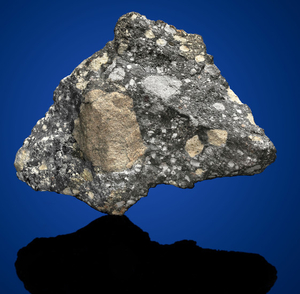NWA 12691 — FRAGMENT OF THE MOON, BELONGING TO THE NWA 8046 CLAN OF LUNAR METEORITES, Lunar Feldspathic Breccia Sahara Desert, Mauritania
The specimen now offered is an archetypal lunar feldspathic breccia. Hues from the Sahara Desert accent the external surface. While one corner exhibits steep slopes from a singular ridge, more typically gently slopes to its edges. The classic characteristics of a feldspathic lunar breccia are exhibited: anorthite clasts are suspended in a charcoal lunar groundmass “cemented’ together as part of a melt that solidified. Its primary minerals are anorthite, olivine, pigeonite, augite, pigeonite, fayalite, silica, ilmenite and kamacite. The brecciation seen is the result of the ongoing bombardment of the Moon’s surface by asteroid impacts prior to the collision responsible for launching this Moon rock to Earth. Modern cutting.
49 x 82 x 34 mm. (2 x 3.25 x 1.33 in.)
151.9 g. (0.33 lbs.)
The Moon is among the rarest substances on Earth. Less than 600 kg of lunar meteorites are known to exist. All would fit inside four foot lockers and a significant portion is controlled by governmental institutions. While Apollo astronauts returned with close to 400 kg of Moon rocks, not one milligram of this material is available for private ownership. Scientists identify Moon rocks by their specific textural, mineralogical, chemical and isotopic signatures. Many of the common minerals found on Earth’s surface are rare on the Moon and some lunar minerals are unknown on Earth. In addition, Moon rocks contain gases captured from the solar wind with isotope ratios very different from the same gases found on Earth. Lunar meteorites arrived on Earth after having been blasted off the lunar surface following an asteroid impact—and it’s such impacts that created the vast majority of the Moon’s craters. This particular meteorite was part of a large meteorite shower straddling the Algerian and Mauritanian borders. As multiple specimens from what were thought to be different events were analyzed, it turned out they all originate from the same impact event; NWA 8046 was the first of these specimens, and the meteorites belonging to this event are referred to as being members of the NWA 8046 clan. The choice lunar sample now offered is the end cap of the following lot. As one would expect, many of the Moon rocks returned by Apollo missions are nearly identical to lunar meteorites—and such is the case here.
Christie's would like to thank Dr. Alan E. Rubin at the Institute of Geophysics and Planetary Physics, University of California, Los Angeles for his assistance in preparing this catalogue note.
View it on
Estimate
Time
Auction House
The specimen now offered is an archetypal lunar feldspathic breccia. Hues from the Sahara Desert accent the external surface. While one corner exhibits steep slopes from a singular ridge, more typically gently slopes to its edges. The classic characteristics of a feldspathic lunar breccia are exhibited: anorthite clasts are suspended in a charcoal lunar groundmass “cemented’ together as part of a melt that solidified. Its primary minerals are anorthite, olivine, pigeonite, augite, pigeonite, fayalite, silica, ilmenite and kamacite. The brecciation seen is the result of the ongoing bombardment of the Moon’s surface by asteroid impacts prior to the collision responsible for launching this Moon rock to Earth. Modern cutting.
49 x 82 x 34 mm. (2 x 3.25 x 1.33 in.)
151.9 g. (0.33 lbs.)
The Moon is among the rarest substances on Earth. Less than 600 kg of lunar meteorites are known to exist. All would fit inside four foot lockers and a significant portion is controlled by governmental institutions. While Apollo astronauts returned with close to 400 kg of Moon rocks, not one milligram of this material is available for private ownership. Scientists identify Moon rocks by their specific textural, mineralogical, chemical and isotopic signatures. Many of the common minerals found on Earth’s surface are rare on the Moon and some lunar minerals are unknown on Earth. In addition, Moon rocks contain gases captured from the solar wind with isotope ratios very different from the same gases found on Earth. Lunar meteorites arrived on Earth after having been blasted off the lunar surface following an asteroid impact—and it’s such impacts that created the vast majority of the Moon’s craters. This particular meteorite was part of a large meteorite shower straddling the Algerian and Mauritanian borders. As multiple specimens from what were thought to be different events were analyzed, it turned out they all originate from the same impact event; NWA 8046 was the first of these specimens, and the meteorites belonging to this event are referred to as being members of the NWA 8046 clan. The choice lunar sample now offered is the end cap of the following lot. As one would expect, many of the Moon rocks returned by Apollo missions are nearly identical to lunar meteorites—and such is the case here.
Christie's would like to thank Dr. Alan E. Rubin at the Institute of Geophysics and Planetary Physics, University of California, Los Angeles for his assistance in preparing this catalogue note.



